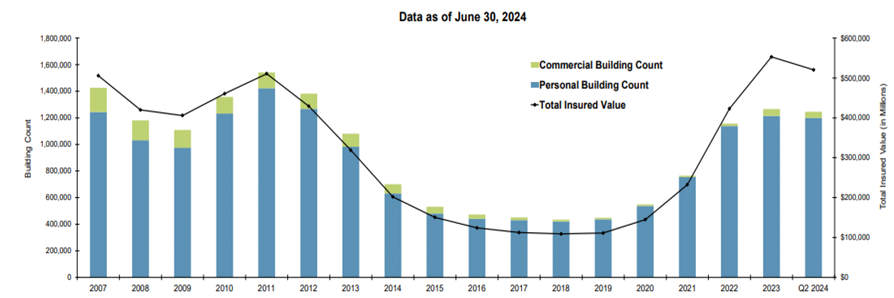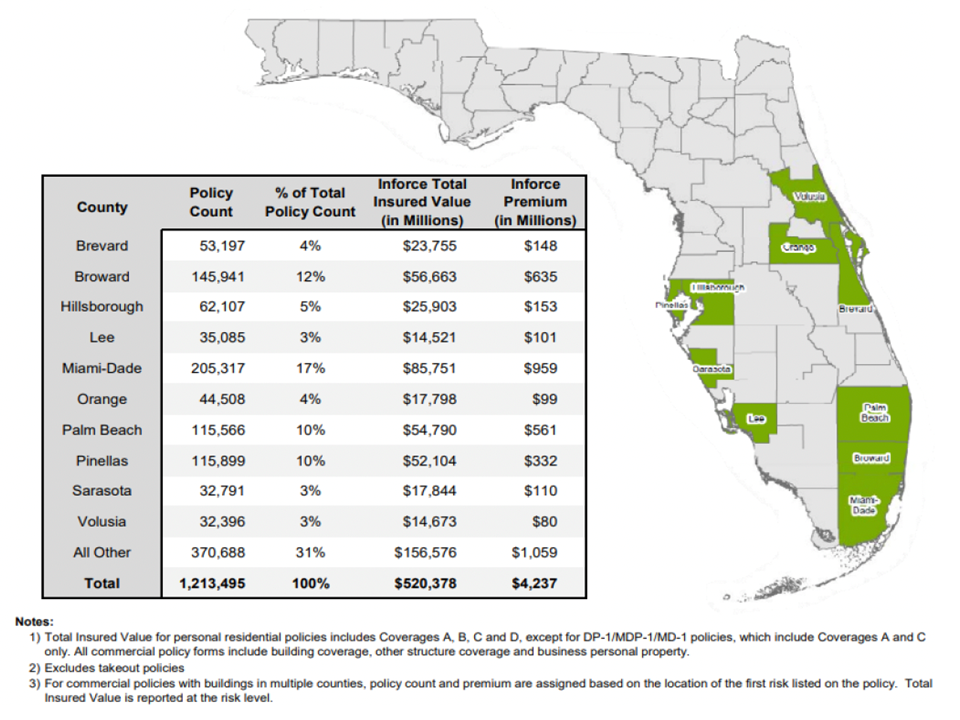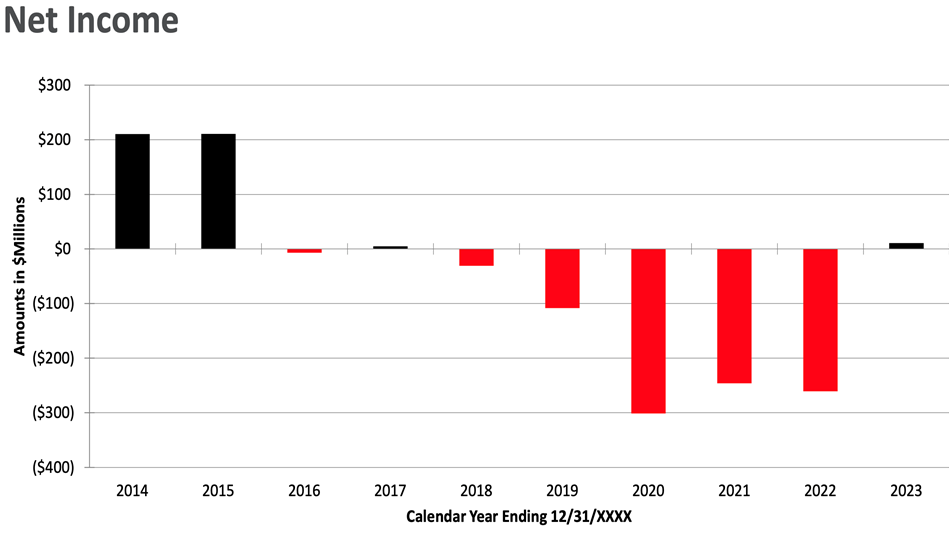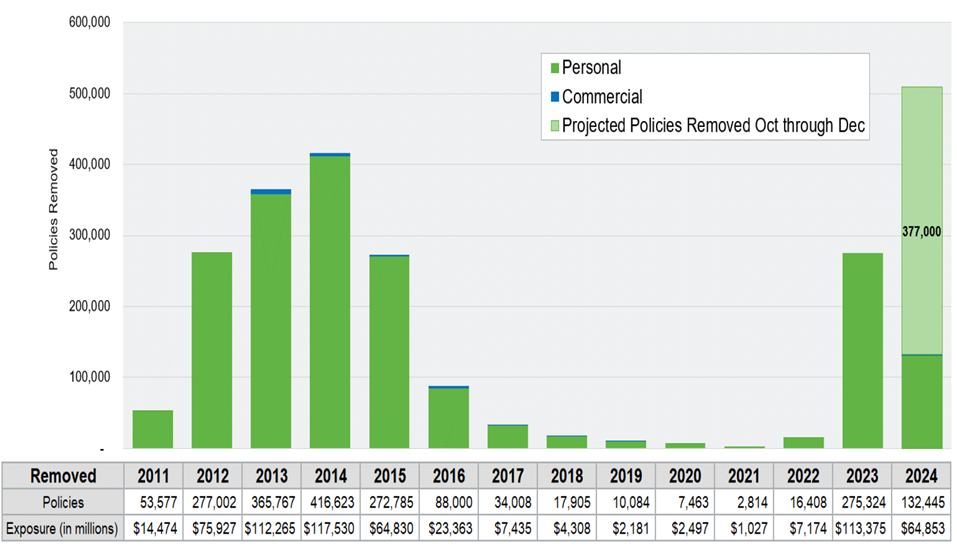The sun is shining in the homeowners insurance market in the Sunshine State after a tumultuous few years. On the heels of major CAT events, such as hurricanes Irma (2017) and Ian (2022), losses from assignment of benefit (AOB) claims, rampant litigation, and ever-rising reinsurance costs, Florida property writers struggled to stay afloat. Many private writers became insolvent, leading to a significant increase in policies assumed by Citizens Property Insurance, Florida’s insurer of last resort. As new start-ups enter the private market, a much-needed Citizens depopulation is on-going and the storm clouds appear to have cleared in the Florida property market.
Citizens Property Insurance, a nonprofit, state-backed entity was formed in 2002 to provide insurance to Florida property owners unable to obtain coverage in the private market. Citizens was established as the insurer of last resort to provide limited coverage at a much higher rate than the private market. Rates in the private market have spiked precipitously in order for companies to maintain solvency as a result of rising inflation, and therefore, higher replacement costs, assignment of benefit (AOB) claims and litigation, and rising reinsurance costs. By Florida statute, Citizens is limited to a 15% annual increase in rates, well below the rates offered in the private market over the last few years, leaving Florida homeowners turning to the insurer of last resort for primary coverage. Citizens policy counts have increased exponentially as nine private insurers became insolvent between 2021-2023. Higher reinsurance costs, assignment of benefit (AOB) related claims and excessive litigation, driven by false roofing claims, are the primary culprits for the failures. Larger, national carriers also left the state as a result. Citizens policy count stood at 1,213,495 at the end of the second quarter of 2024, relative to 427,397 at year end 2018 (Exhibit 1). Citizens is now the largest home insurer in the state of Florida. Problematically, many policies are geographically located in the highly populated, volatile Tri-County area including Miami-Dade, Broward, and Palm Beach (Exhibit 2). If, and potentially when, a major storm makes landfall in or near the Tri-County area, policyholders and Florida taxpayers will be assessed heavily to finance the losses.
Exhibit 1

Exhibit 2

In an effort to support the market and expand insurance options outside of Citizens, Senate Bill 2-A (SB 2-A) was passed in December of 2022. SB 2-A banned assignment of benefit (AOB) claims on future policies and repealed one-way attorney fees, a major cost to Florida property writers. As a result of the legislative changes, optimism is abound and litigation is down pointedly in 2024 relative to the period prior to SB 2-A’s passage in 2022 (Exhibit 3). The private market posted positive net income in 2023 as companies turned profitable in the relatively loss-free year (Exhibit 4). Nine new start-up property insurers have entered the market and an essential depopulation of Citizens policies followed, known as take-outs to private insurers. Depopulation is the term used to describe the reduction in the number of Citizens policies to encourage private insurers to boost their book of business in the state, either as established insurers or new entrants. The take-outs are an attempt to mitigate the state’s risk and is a net positive for the state of Florida. In 2023, 270,751 policies were removed from Citizens, with an additional 132,445 through the second quarter of 2024 (Exhibit 5). In the final three months of 2024, an additional 377k policies are to be assumed by private insurers (Exhibit 6). More importantly, Citizen’s market share of the volatile Tri-County area reduced to 38% from around 50% of all policies.
Exhibit 3

Exhibit 4

Exhibit 5

Exhibit 6

An additional bright spot on the horizon is the revival of the reinsurance market. Reinsurance rates peaked in 2023 after CAT losses from Hurricane Ian, as well as losses from AOB-related claims and litigation. Prior to 2024, double digit increases in the prior three renewal periods had priced-out many Florida property writers and reinsurers fled the state. Those who remained in the Florida market significantly decreased capacity. Today, reinsurers seem to value the SB 2-A reform, CAT-free 2023, and higher primary rates as evidenced by a resurgence in the number of reinsurers bringing expanded capacity to the state. Despite two recent hurricanes, Helene and Milton, reinsurance pricing is expected to be generally flat for 2025 renewals. Projections show the majority of savings will come from the middle and top layers, with a potential increase in the bottom layers more heavily impacted by inflation and smaller CAT events.
All signs point to a bright market in Florida after years that left a trail of destruction. New entrants will bring competition back to the market, Citizens should see its policy count decline as depopulation continues, legislative reforms should continue to limit litigation, and increased capacity within the reinsurance market should provide a backstop to future loss years. As the book closes on the 2024 hurricane season, the sun is shining bright once again on the insurance market in the Sunshine State.
Disclaimer: Asset Allocation & Management Company, LLC (AAM) is an investment adviser registered with the Securities and Exchange Commission, specializing in fixed-income asset management services for insurance companies. Registration does not imply a certain level of skill or training. This information was developed using publicly available information, internally developed data and outside sources believed to be reliable. While all reasonable care has been taken to ensure that the facts stated and the opinions given are accurate, complete and reasonable, liability is expressly disclaimed by AAM and any affiliates (collectively known as “AAM”), and their representative officers and employees. This report has been prepared for informational purposes only and does not purport to represent a complete analysis of any security, company or industry discussed. Any opinions and/or recommendations expressed are subject to change without notice and should be considered only as part of a diversified portfolio. Any opinions and statements contained herein of financial market trends based on market conditions constitute our judgment. This material may contain projections or other forward-looking statements regarding future events, targets or expectations, and is only current as of the date indicated. There is no assurance that such events or targets will be achieved, and may be significantly different than that discussed here. The information presented, including any statements concerning financial market trends, is based on current market conditions, which will fluctuate and may be superseded by subsequent market events or for other reasons. Although the assumptions underlying the forward-looking statements that may be contained herein are believed to be reasonable they can be affected by inaccurate assumptions or by known or unknown risks and uncertainties. AAM assumes no duty to provide updates to any analysis contained herein. A complete list of investment recommendations made during the past year is available upon request. Past performance is not an indication of future returns. This information is distributed to recipients including AAM, any of which may have acted on the basis of the information, or may have an ownership interest in securities to which the information relates. It may also be distributed to clients of AAM, as well as to other recipients with whom no such client relationship exists. Providing this information does not, in and of itself, constitute a recommendation by AAM, nor does it imply that the purchase or sale of any security is suitable for the recipient. Investing in the bond market is subject to certain risks including market, interest-rate, issuer, credit, inflation, liquidity, valuation, volatility, prepayment and extension. No part of this material may be reproduced in any form, or referred to in any other publication, without express written permission.